Sport in Ireland
Hurling is
the most ancient indigenous sport of Ireland (featuring in such pre-Christian legends as Cúchulainn)
but
Gaelic football is more popular. Soccer and rugby unions are also
popular, and the Irish are noted for turning up in great numbers for virtually
any sporting occaison where there are Irish competing.
Gaelic Athletic Association
Hurling
Gaelic football
Gaelic Athletic Association
 The Gaelic Athletic Association (The GAA) (Irish: Cumann
Lúthchleas Gael) is an organisation which is mostly focused on promoting
gaelic games (Irish sports) such as hurling and camogie, Gaelic football and handball, and rounders
not only in the Republic but also in Northern Ireland. The
organisation also promotes Irish music and dance,
and the Irish language as an
integral part of its objectives. The organisation is based on the traditional parishes and counties of Ireland.
It is the largest and most popular organisation in Ireland (established in 1884)
with some 800,000 members out of the island's 5 million people.
The Gaelic Athletic Association (The GAA) (Irish: Cumann
Lúthchleas Gael) is an organisation which is mostly focused on promoting
gaelic games (Irish sports) such as hurling and camogie, Gaelic football and handball, and rounders
not only in the Republic but also in Northern Ireland. The
organisation also promotes Irish music and dance,
and the Irish language as an
integral part of its objectives. The organisation is based on the traditional parishes and counties of Ireland.
It is the largest and most popular organisation in Ireland (established in 1884)
with some 800,000 members out of the island's 5 million people.
Aims of the GAA:
1. To foster and promote the native Irish pastimes.
2. To open athletics to all social classes.
3. To aid in the establishment of hurling and football clubs which would
organise matches between counties.
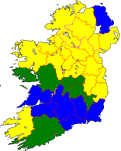 Yellow
on the map indicates a Gaelic football county, blue a hurling county
and green a "dual county", where both sports are equally
popular. Gaelic football is obviously the most popular sport.
Yellow
on the map indicates a Gaelic football county, blue a hurling county
and green a "dual county", where both sports are equally
popular. Gaelic football is obviously the most popular sport.
Hurling
Hurling (Irish: Iomáint) is an outdoor team sport of Celtic
origin, played with sticks and a ball. The women's variant of hurling
is called Camogie. Hurling was first mentioned in a description of the
14th century BC Battle of Moytura. Hurling has also been mentioned in several
other old Irish sources since and the game has enjoyed popularity through the
ages. The game, played primarily in Ireland, is
arguably the world's fastest field team sport in terms of
game play (however the ball travels faster in other field games such as hockey).
It resembles the games of
shinty that is
played primarily in Scotland, and bandy
that was played formerly in England and Wales. Hurling is one of Ireland's native sports. Since 1884,
hurling has been governed by the
Gaelic Athletic Association (GAA). The most important match is the GAA
All-Ireland Intercounty Championship which takes place annually in a modified
knock-out format (egyenes kieséses). The final matches are played at Croke Park
and regularly attract attendances of up to 83,000 people. Significant hurling matches are those between the
counties of Ireland in each of the four
national provinces.
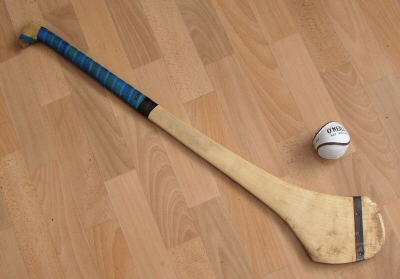 The pitch is of grass and rectangular, stretching 130-150 metres long and
80–90 metres wide (it's like a soccer field). There are H-shaped goalposts at
each end with a net on the bottom section. A team comprises 15 players. The
objective of this field game is for one of two teams to score more goals and
points, during a match, than the other. Each player has a stick for handling,
carrying and hitting the ball. The stick, which is known as a
hurley or camán, is generally 25–38 inches (64–97 cm) in length with a flat face opposite its
handle called a bas. The ball, which is known as a sliotar, is
made of leather and is 2.55 inches (65 mm) in diameter. The goalkeeper's hurley
has a bas twice the size of other players' hurleys to provide some
advantage for the fast moving sliotar. A good strike with a stick can propel the
ball up to 93 mph (150 km per hour) in speed and 262 feet (80 m) in distance.
The pitch is of grass and rectangular, stretching 130-150 metres long and
80–90 metres wide (it's like a soccer field). There are H-shaped goalposts at
each end with a net on the bottom section. A team comprises 15 players. The
objective of this field game is for one of two teams to score more goals and
points, during a match, than the other. Each player has a stick for handling,
carrying and hitting the ball. The stick, which is known as a
hurley or camán, is generally 25–38 inches (64–97 cm) in length with a flat face opposite its
handle called a bas. The ball, which is known as a sliotar, is
made of leather and is 2.55 inches (65 mm) in diameter. The goalkeeper's hurley
has a bas twice the size of other players' hurleys to provide some
advantage for the fast moving sliotar. A good strike with a stick can propel the
ball up to 93 mph (150 km per hour) in speed and 262 feet (80 m) in distance.
During a match, players attack their opposing goal and protect their own.
When the ball is on the ground, it must be played by striking or lifting it off
the ground with the hurley into the air where it may be struck again or placed
into the hand for four seconds or four steps, whichever comes first. If the ball
is caught, the catching player may not throw it or carry it for the shorter of
four paces or four seconds, but is allowed to strike the ball with a stick or
hand, or by kicking. The hurley's bas may be used to carry the ball while a
player controls it. Accidental collisions between players and equipment do occur and so a plastic
protective helmet with faceguard is recommended. Senior inter-county matches
last 70 minutes (35 minutes a half). All other matches last 60 minutes (30
minutes a half).
Gaelic football
Gaelic football (Irish: peil
ghaelach) is a form of football played mainly in Ireland. The first reference to any code of football in Ireland occurs in
the Statute
of Galway of 1527, which allowed the playing of
football and archery but banned
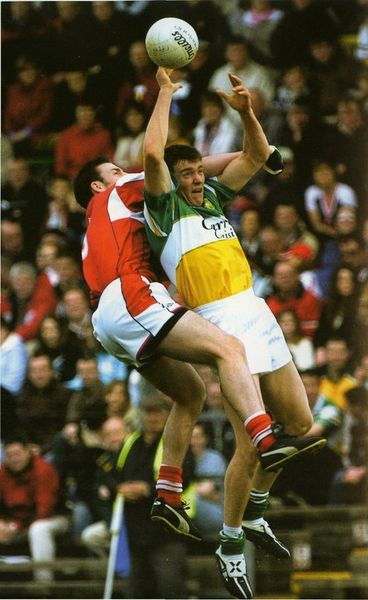 hurling
as well as other sports. At first glance Gaelic Football resembles a combination of soccer and rugby.
The level of tackling allowed is more robust than in soccer, but less than
rugby. Players (15 per team) advance the ball up the field with a combination of
carrying, kicking, and hand-passing to their team-mates. The pitch is the same
that is used for hurling, having H-shaped goalposts at each end with a net on
the bottom section. The goal is guarded by a goalkeeper. The game is played with a round leather ball, similar to a soccer
ball, but heavier. If the ball goes over the crossbar, a point is scored. If the ball goes below the crossbar, a goal,
worth three points, is scored.
hurling
as well as other sports. At first glance Gaelic Football resembles a combination of soccer and rugby.
The level of tackling allowed is more robust than in soccer, but less than
rugby. Players (15 per team) advance the ball up the field with a combination of
carrying, kicking, and hand-passing to their team-mates. The pitch is the same
that is used for hurling, having H-shaped goalposts at each end with a net on
the bottom section. The goal is guarded by a goalkeeper. The game is played with a round leather ball, similar to a soccer
ball, but heavier. If the ball goes over the crossbar, a point is scored. If the ball goes below the crossbar, a goal,
worth three points, is scored.
The following are considered technical fouls ("fouling the ball"):
-
Picking the ball directly off the ground
-
Throwing the ball
-
Going five steps without releasing, bouncing or soloing the ball. (Soloing
involves kicking the ball into one's own hands)
-
Bouncing the ball twice in a row
-
Handpassing the ball over an opponent's head, then running around him to
catch it
-
Handpassing a goal (the ball may be punched into the goal from up in the
air, though)
-
Square ball, an often controversial rule: If, at the moment the ball
enters the small rectangle, there is already an attacking player inside the
small rectangle, then a free out is awarded.
On a national level, the team is organised on the old Irish county system, producing 34 teams
(Dublin has more than one) representing the original 32
counties that cover the island of Ireland, plus teams representing the Irish
diaspora in London and New York. Though Ireland was partitioned into two states
in 1920, Gaelic sports (like most cultural organisations)
continue to be organised on an all-island basis. Nearly all counties play
against each other in a knockout tournament known as the All Ireland Championship.
The games are organised on the four Irish provinces of Ulster, Munster, Leinster
and Connacht. The best team from each would play one of the others, at a stage
known as the All-Ireland semi-finals, with the winning team from each game
playing each other in the All-Ireland
Final
which takes place on the fourth Sunday of September in Croke Park, Dublin. Over the four Sundays of September, All Ireland Finals
in men's football, women's football, hurling and camogie take place in Croke
Park, the national stadium of the GAA.
sources:
Wikipedia:
Gaelic football, Hurling
sources & credits:
1.
Hurling photos
©
Cushendun Emmets GAC
2006
2. Gaelic football:
extracted from
Wikipedia The Free Encyclopedia
under
GNU Free Documentation Licence.
3.
Hurling:
extracted from
Wikipedia The Free Encyclopedia
under
GNU Free Documentation Licence.
4.
GAA:
extracted from
Wikipedia The Free Encyclopedia
under
GNU Free Documentation Licence.
 The Gaelic Athletic Association (The GAA) (Irish: Cumann
Lúthchleas Gael) is an organisation which is mostly focused on promoting
gaelic games (Irish sports) such as hurling and camogie, Gaelic football and handball, and rounders
not only in the Republic but also in Northern Ireland. The
organisation also promotes Irish music and dance,
and the Irish language as an
integral part of its objectives. The organisation is based on the traditional parishes and counties of Ireland.
It is the largest and most popular organisation in Ireland (established in 1884)
with some 800,000 members out of the island's 5 million people.
The Gaelic Athletic Association (The GAA) (Irish: Cumann
Lúthchleas Gael) is an organisation which is mostly focused on promoting
gaelic games (Irish sports) such as hurling and camogie, Gaelic football and handball, and rounders
not only in the Republic but also in Northern Ireland. The
organisation also promotes Irish music and dance,
and the Irish language as an
integral part of its objectives. The organisation is based on the traditional parishes and counties of Ireland.
It is the largest and most popular organisation in Ireland (established in 1884)
with some 800,000 members out of the island's 5 million people. Yellow
on the map indicates a Gaelic football county, blue a hurling county
and green a "dual county", where both sports are equally
popular. Gaelic football is obviously the most popular sport.
Yellow
on the map indicates a Gaelic football county, blue a hurling county
and green a "dual county", where both sports are equally
popular. Gaelic football is obviously the most popular sport. The pitch is of grass and rectangular, stretching 130-150 metres long and
80–90 metres wide (it's like a soccer field). There are H-shaped goalposts at
each end with a net on the bottom section. A team comprises 15 players. The
objective of this field game is for one of two teams to score more goals and
points, during a match, than the other. Each player has a stick for handling,
carrying and hitting the ball. The stick, which is known as a
hurley or camán, is generally 25–38 inches (64–97 cm) in length with a flat face opposite its
handle called a bas. The ball, which is known as a sliotar, is
made of leather and is 2.55 inches (65 mm) in diameter. The goalkeeper's hurley
has a bas twice the size of other players' hurleys to provide some
advantage for the fast moving sliotar. A good strike with a stick can propel the
ball up to 93 mph (150 km per hour) in speed and 262 feet (80 m) in distance.
The pitch is of grass and rectangular, stretching 130-150 metres long and
80–90 metres wide (it's like a soccer field). There are H-shaped goalposts at
each end with a net on the bottom section. A team comprises 15 players. The
objective of this field game is for one of two teams to score more goals and
points, during a match, than the other. Each player has a stick for handling,
carrying and hitting the ball. The stick, which is known as a
hurley or camán, is generally 25–38 inches (64–97 cm) in length with a flat face opposite its
handle called a bas. The ball, which is known as a sliotar, is
made of leather and is 2.55 inches (65 mm) in diameter. The goalkeeper's hurley
has a bas twice the size of other players' hurleys to provide some
advantage for the fast moving sliotar. A good strike with a stick can propel the
ball up to 93 mph (150 km per hour) in speed and 262 feet (80 m) in distance.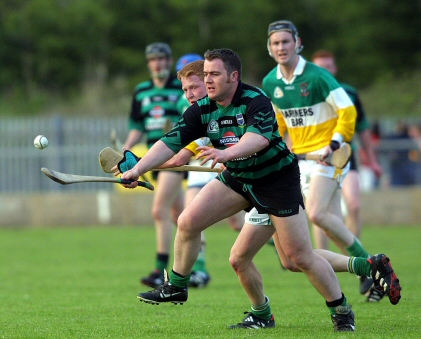
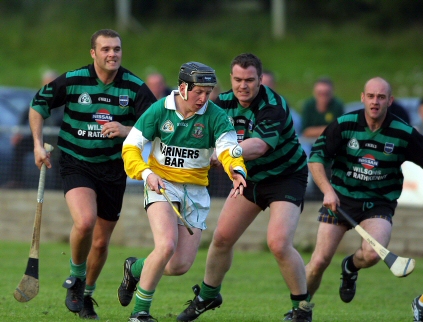
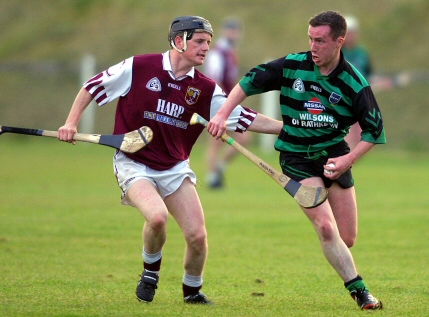

 hurling
as well as other sports. At first glance Gaelic Football resembles a combination of soccer and rugby.
The level of tackling allowed is more robust than in soccer, but less than
rugby. Players (15 per team) advance the ball up the field with a combination of
carrying, kicking, and hand-passing to their team-mates. The pitch is the same
that is used for hurling, having H-shaped goalposts at each end with a net on
the bottom section. The goal is guarded by a goalkeeper. The game is played with a round leather ball, similar to a soccer
ball, but heavier. If the ball goes over the crossbar, a point is scored. If the ball goes below the crossbar, a goal,
worth three points, is scored.
hurling
as well as other sports. At first glance Gaelic Football resembles a combination of soccer and rugby.
The level of tackling allowed is more robust than in soccer, but less than
rugby. Players (15 per team) advance the ball up the field with a combination of
carrying, kicking, and hand-passing to their team-mates. The pitch is the same
that is used for hurling, having H-shaped goalposts at each end with a net on
the bottom section. The goal is guarded by a goalkeeper. The game is played with a round leather ball, similar to a soccer
ball, but heavier. If the ball goes over the crossbar, a point is scored. If the ball goes below the crossbar, a goal,
worth three points, is scored.